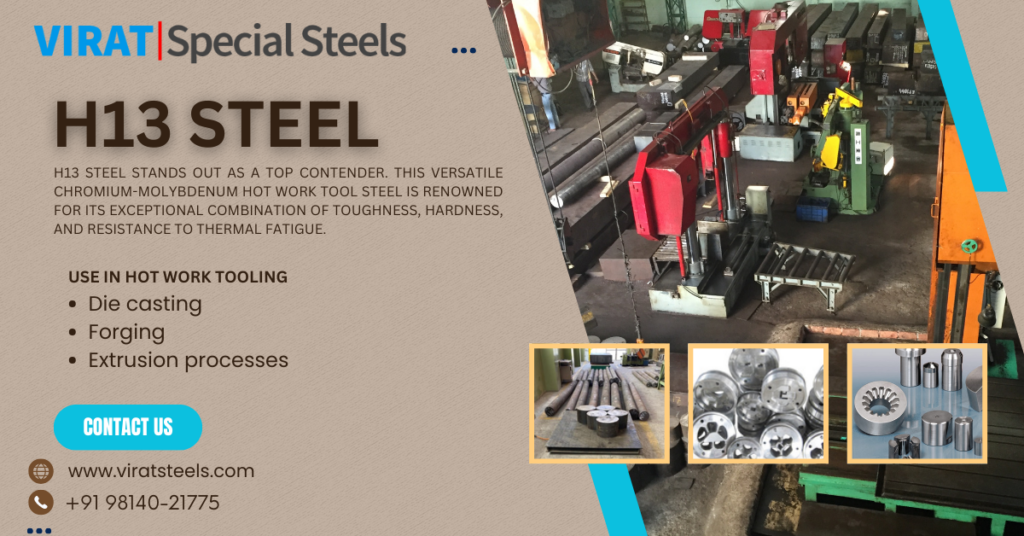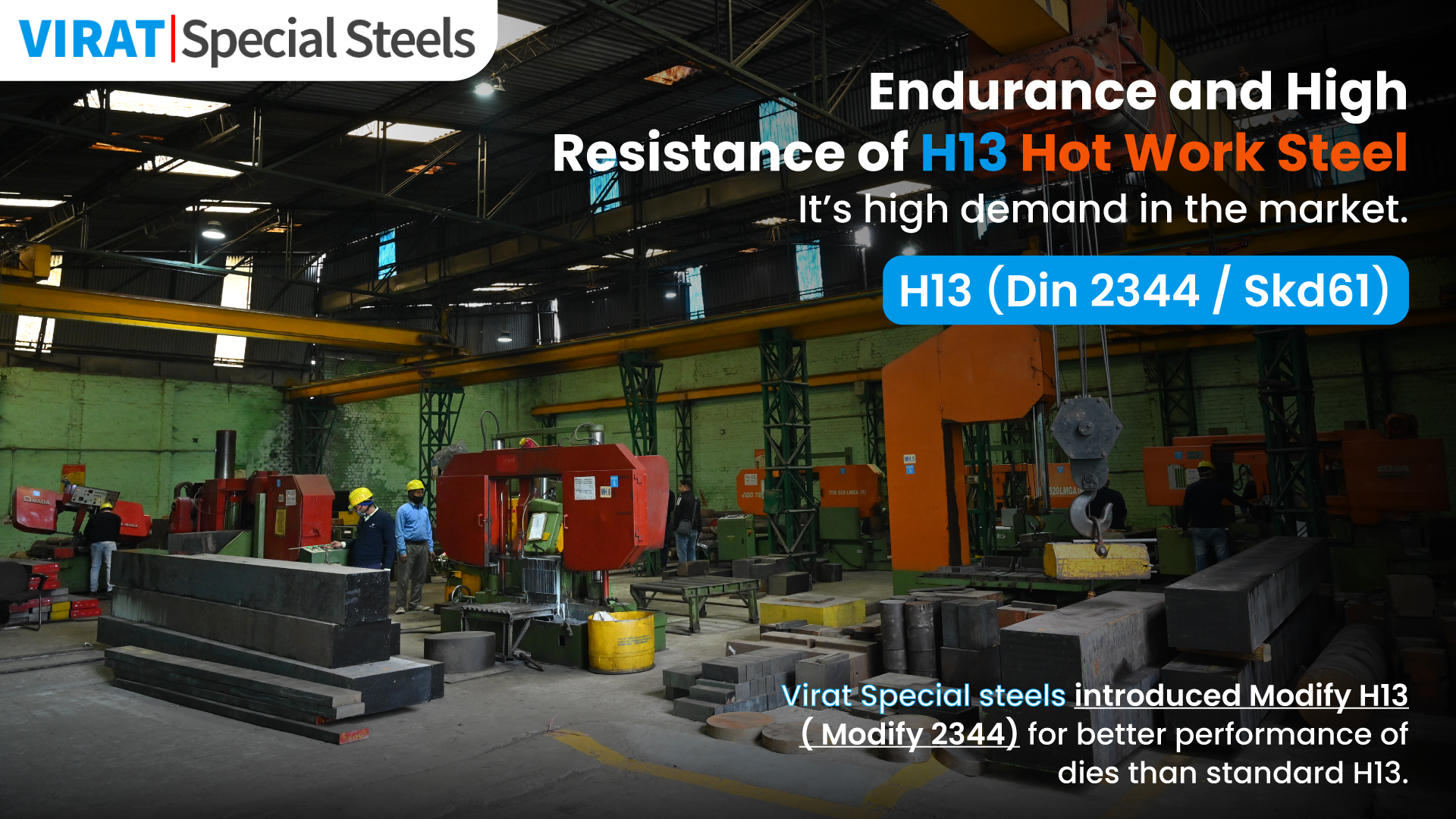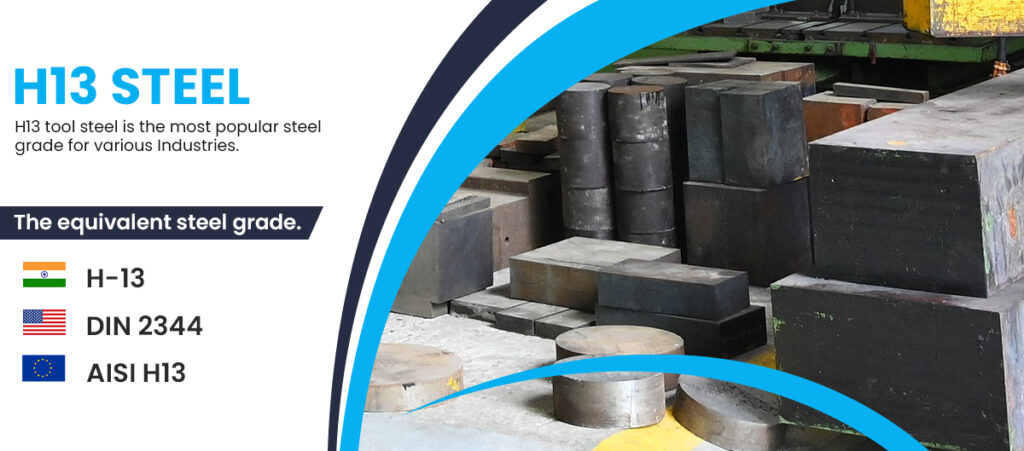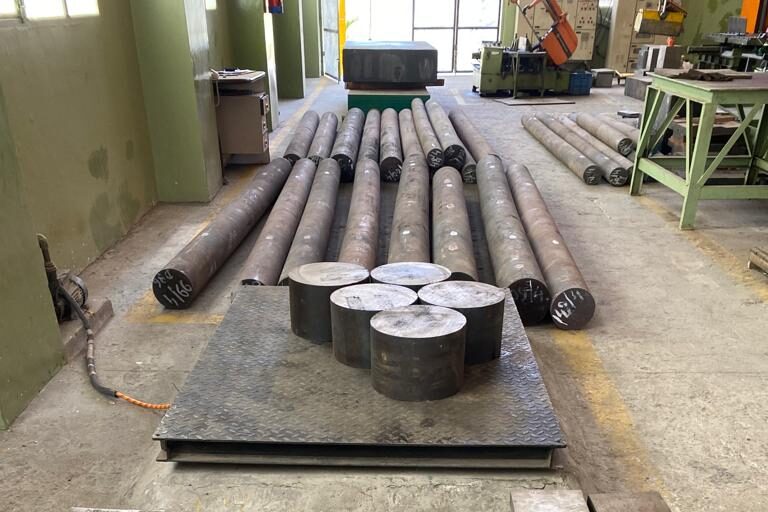H13 is the preferred choice
now browsing by category
What is H13 Steel and Its Applications?
Introduction
When it comes to materials that can withstand extreme conditions, H13 steel stands out as a top contender. This versatile chromium-molybdenum hot work tool steel is renowned for its exceptional combination of toughness, hardness, and resistance to thermal fatigue. Its unique properties make it indispensable across various industries, from automotive to aerospace.

Chemical Composition of H13 Steel
The remarkable characteristics of H13 steel are rooted in its specific chemical makeup. The typical composition includes:
- Carbon (C): 0.32 – 0.40%
- Chromium (Cr): 5.13 – 5.25%
- Molybdenum (Mo): 1.33 – 1.4%
- Vanadium (V): 1.0%
- Silicon (Si): 1.0%
- Manganese (Mn): 0.20 – 0.50%
Each element plays a pivotal role:
- Carbon enhances hardness and strength.
- Chromium improves hardenability and resistance to oxidation.
- Molybdenum increases toughness and high-temperature strength.
- Vanadium contributes to wear resistance and grain refinement.
- Silicon boosts strength and elasticity.
- Manganese aids in deoxidation during steel production.
This balanced composition ensures that H13 steel maintains its integrity under demanding conditions.
Physical Properties of H13 Steel
Understanding the physical properties of H13 steel provides insight into its performance in various applications:
- Density: Approximately 7.80 g/cm³ (0.282 lb/in³)
- Thermal Conductivity: 24.3 W/m-K at 215°C (419°F)
- Coefficient of Thermal Expansion: 11.0 µm/m-°C between 25°C and 95°C
These properties indicate that H13 steel can efficiently conduct heat while maintaining dimensional stability, crucial for tools exposed to rapid temperature changes.
Mechanical Properties of H13 Steel
The mechanical prowess of H13 steel is evident in its ability to withstand substantial stress without deformation:
- Hardness: Rockwell C scale hardness ranges from 28 to 53, depending on heat treatment.
- Tensile Strength: Ultimate tensile strength can reach up to 1990 MPa (289,000 psi).
- Toughness: Demonstrates excellent toughness, essential for resisting cracking under impact.
These attributes make H13 steel suitable for applications requiring both strength and durability.
Heat Treatment Processes for H13 Steel
To optimize its properties, H13 steel undergoes specific heat treatment processes:
- Annealing: Heating to 1550°-1650°F, holding until uniformly heated, then cooling slowly to about 1000°F to soften the steel for machining.
- Hardening: Heating to 1800°-1850°F, followed by air or oil quenching to achieve desired hardness.
- Tempering: Reheating to 1000°-1150°F, depending on the required hardness, to reduce brittleness.
These treatments enhance the steel’s performance in various applications.
Advantages of Using H13 Steel
H13 steel offers several notable benefits:
- High-Temperature Resistance: Maintains strength and hardness at elevated temperatures, making it ideal for hot work applications.
- Wear Resistance: The presence of vanadium carbides provides excellent resistance to abrasion.
- Thermal Fatigue Resistance: Can withstand repeated heating and cooling cycles without cracking.
These advantages contribute to its widespread use in demanding environments.
Applications
1. Applications in Hot Work Tooling
H13 steel is widely used in hot work tooling applications where materials are subjected to high temperatures and extreme mechanical stress. Some of its key applications in this domain include:
- Die Casting Dies: H13 steel is commonly used for die-casting dies due to its excellent heat resistance, wear resistance, and toughness. The ability to withstand the rapid heating and cooling cycles involved in die-casting operations ensures longer tool life.
- Extrusion Dies: In aluminum and other metal extrusion processes, H13 steel is used to manufacture dies that shape and form metal billets. The steel’s strength and thermal stability prevent premature wear and deformation.
- Forging Dies: H13 steel is used in the production of forging dies that shape metal parts through high-pressure impacts. The toughness and heat resistance of H13 help the dies maintain their shape under extreme conditions.
These applications make H13 an indispensable material in the hot work tooling industry, ensuring efficiency, precision, and durability.
2. Applications in Cold Work Tooling
Although primarily known for hot work applications, H13 steel also finds limited usage in cold work tooling where wear resistance and impact strength are required. Some examples include:
- Shear Blades: H13 steel is used for manufacturing shear blades that cut or trim metal sheets, where its hardness and durability contribute to precision and long service life.
- Stamping Dies: H13 is occasionally used in stamping dies for cold-forming applications, where its wear resistance helps maintain die integrity.
- Plastic Molds: While more common in hot work environments, H13 is also used for plastic injection molding where high strength and heat resistance are necessary.
Although other cold work steels like D2 or O1 may be preferred for most cold work applications, H13’s versatility allows it to be used where both wear resistance and toughness are required.
3. Use in Plastic Injection Molding
H13 steel is one of the top choices for plastic injection molding tools, particularly for mold inserts. Some advantages include:
- High Thermal Conductivity: Ensures efficient heat dissipation, reducing cycle times and improving productivity.
- Wear and Corrosion Resistance: Prevents mold degradation, ensuring longevity and consistent production quality.
- Dimensional Stability: H13 maintains its structure under high pressure and temperature, reducing warping and defects in molded parts.
These properties make H13 a preferred material for injection molding applications, where durability and precision are critical.
4. H13 Steel in the Automotive Industry
The automotive sector relies on H13 steel for various high-performance applications. Some of the most common uses include:
- Engine Components: H13 steel is used in manufacturing engine components such as cylinder heads, pistons, and exhaust valves, where high-temperature resistance is necessary.
- Structural Parts: Some automotive manufacturers use H13 in critical structural components that must withstand mechanical and thermal stress.
- Tooling for Manufacturing: Many of the dies and molds used in automotive production, including stamping dies and injection molds, are made from H13 steel.
The exceptional properties of H13 steel help improve the durability and performance of automotive parts and manufacturing processes.
5. H13 Steel in the Aerospace Industry
The aerospace industry demands materials with superior strength, heat resistance, and toughness. H13 steel meets these requirements and is used in:
- Turbine Blades: Due to its heat resistance, H13 is used in manufacturing certain aerospace turbine components exposed to high temperatures.
- Structural Components: Some aerospace structures, including landing gear and support brackets, benefit from the toughness of H13 steel.
With the aerospace industry constantly pushing for high-performance materials, H13 remains a strong candidate for demanding applications.
Conclusion
H13 steel is a versatile and high-performance material used in numerous industries, including automotive, aerospace, die-casting, and injection molding. Its unique combination of high-temperature resistance, wear resistance, and toughness makes it an ideal choice for hot work tooling and other demanding applications. While it has some limitations, proper heat treatment and machining techniques help maximize its benefits. Whether in the production of industrial tools, aerospace components, or plastic molds, H13 remains a top-tier tool steel for high-performance applications.
Mode of Supply
Virat Special Steels is the largest stockiest and supplier of H13 tool steel in flat, square and round bar. We provide steel in all sizes as your requirements. H13 die steel is available in flat, square and round shape. Consult our team who will assist you for h13 steel query.
FAQs
1. What makes H13 steel suitable for high-temperature applications?
H13 steel has excellent thermal fatigue resistance, high wear resistance, and superior toughness, making it ideal for high-temperature applications such as die casting and forging.
2. How does H13 steel compare to D2 tool steel?
H13 is better suited for high-temperature applications, while D2 is a cold work steel with superior wear resistance. Choosing between them depends on whether heat resistance or abrasion resistance is a priority.
3. Can H13 steel be welded?
Yes, H13 steel can be welded, but it requires preheating and post-weld heat treatment to prevent cracking and ensure structural integrity.
4. What industries commonly use H13 steel?
H13 steel is widely used in die-casting, plastic injection molding, aerospace, automotive manufacturing, and hot work tooling applications.
5. How does heat treatment affect H13 steel?
Proper heat treatment enhances H13 steel’s hardness, strength, and resistance to thermal fatigue, ensuring optimal performance in demanding applications.
Why H13 Steel is Ideal for Hot Work Tool Applications?
When it comes to hot work tool applications, durability, heat resistance, and toughness are crucial. Among the range of available materials, H13 steel consistently stands out as a top choice. Known for its exceptional properties, H13 is widely used across industries for die-casting, forging, and extrusion applications. Let’s delve deeper into what makes H13 steel ideal for such demanding environments.
Introduction to H13 Steel
Overview of Tool Steels
Tool steels are specially designed to handle extreme conditions, whether it’s the heat in hot work applications or stress in cutting and machining. They are classified into types like hot work, cold work, and plastic mold steels based on their intended applications. These steels are manufactured with alloying elements to impart specific qualities like wear resistance, toughness, and thermal conductivity.
What Makes H13 Steel Unique?
H13 steel is a chromium-molybdenum-vanadium alloy, which sets it apart as a hot work tool steel. It’s the balance of heat resistance, toughness, and wear resistance that makes H13 an industry favorite. With a reputation for excellent machinability, resistance to thermal fatigue, and exceptional durability, H13 ensures reliable performance in the harshest environments.

Properties of H13 Steel That Make it Suitable for Hot Work
High Thermal Resistance
H13 steel is renowned for its ability to withstand high operating temperatures without deforming. This property is particularly valuable in hot work applications like die-casting and forging, where tools are exposed to prolonged heat cycles.
Excellent Toughness
What makes H13 exceptional is its ability to endure immense pressure and impact without cracking. This toughness not only prolongs the tool’s lifespan but also improves operational safety.
Resistance to Thermal Fatigue
Repeated heating and cooling cycles can degrade many materials, but H13 shines in this area. Its thermal fatigue resistance ensures consistent performance over time, even in extreme conditions like die-casting where rapid temperature changes occur frequently.
Applications of H13 Steel in Hot Work Tools
Die-Casting Molds
In die-casting, molten metals are injected into molds to create precision parts. H13 steel’s ability to endure the high temperatures and pressures involved makes it the perfect choice for this application.
Forging Dies
The forging process involves shaping metals under intense heat and pressure. H13’s toughness and wear resistance ensure that dies made from this material maintain their integrity and accuracy over time.
Extrusion Dies
Extrusion processes subject dies to prolonged heat and force. H13 steel, with its superior heat resistance and durability, ensures smooth operations and minimizes downtime in this challenging application.
Comparison of H13 with Other Tool Steels
H13 vs. D2 Steel
While D2 steel is excellent for wear resistance in cold work, it lacks the high-temperature strength of H13. For hot work applications, H13 is the preferred option.
H13 vs. P20 Steel
P20 is widely used in plastic mold applications, but it cannot handle the extreme heat and thermal fatigue associated with hot work. H13, in contrast, thrives in high-temperature environments.
Advantages of Using H13 Steel in Toolmaking
Cost-Effectiveness
Although H13 steel may have a higher upfront cost, its longer service life and superior performance in demanding conditions make it a cost-effective choice in the long run.
Performance Consistency
Industries rely on H13 steel because it delivers consistent results in extreme conditions. This reliability ensures smooth operations and minimizes production losses.
Versatility
While H13 shines in hot work applications, its qualities make it suitable for other uses, including cold work to some extent, adding to its versatility.
Challenges and Maintenance of H13 Steel
Common Challenges
Despite its robust properties, H13 steel is not immune to wear and tear. Prolonged exposure to oxidation and improper heat treatment can impact its performance.
Proper Maintenance Practices
Proper maintenance, such as routine inspections, heat treatments, and ensuring an adequate cooling system, is essential for maximizing the tool life of H13 steel.
Selecting the Right H13 Steel
Importance of Quality
Not all H13 steel is created equal. Choosing a reliable supplier ensures the steel meets industry standards and delivers the desired performance.
Why Virat Special Steels Is Your Trusted Partner
Virat Special Steels is a leading name in delivering high-quality H13 steel tailored for diverse industrial needs. Their commitment to quality and technical expertise makes them the go-to choice for businesses across the globe.
Conclusion
H13 steel sets the standard for hot work applications, offering unmatched durability, heat resistance, and reliability. From die-casting to forging, its exceptional properties ensure that tools perform optimally even in the most demanding environments. For businesses that prioritize performance and longevity, H13 steel is a top choice, and Virat Special Steels ensures the highest quality material for your industrial needs.
FAQs
- What makes H13 steel different from other hot work tool steels?
Its unique composition of chromium, molybdenum, and vanadium ensures a perfect balance of heat resistance and toughness. - Can H13 steel be used in cold work applications?
While not specifically designed for cold work, its toughness and wear resistance make it versatile enough for some such uses. - What industries benefit the most from using H13 steel tools?
Industries like automotive, aerospace, and manufacturing rely heavily on H13 steel for die-casting and forging applications. - How does heat treatment impact the performance of H13 steel?
Proper heat treatment enhances the durability, toughness, and fatigue resistance of H13 steel, ensuring it performs consistently under stress. - Why choose Virat Special Steels for H13 steel?
Virat Special Steels offers unmatched quality and expertise, delivering H13 steel that meets stringent industrial standards.
Contact us today to learn more about how H13 tool steel can serve your production needs and help your business achieve optimal efficiency and precision.
Partner with Virat Special Steels for quality, expertise, and reliable H13 solutions.
Whether you’re in the market for robust H13 tool steel or exploring the best options for your next project, #ViratSpecialSteels has got you covered!
Virat Special Steels, INDIA!
https://www.viratsteels.com/h13.html
📞 Contact us today to learn more about how we can support your business!
https://www.viratsteel.in/special-steel-supply-networks/
Any further queries feel free to contact us :
🌐https://www.viratsteels.com/ 📬 info@viratsteels.com ☎+91 98140-21775
H13 Steel: A Comprehensive Guide by Virat Special Steels
Overview of H13 Steel
H13 Steel is a versatile hot-work tool steel highly regarded for its durability, resistance to thermal fatigue, and exceptional strength under high temperatures. This steel type plays a vital role in various industries, from manufacturing heavy-duty dies to precision machining applications. Thanks to its unique properties, H13 Steel stands as one of the most trusted materials in both high-stress and high-temperature environments.
Significance of H13 Steel in Various Industries
Whether it’s the aerospace sector, die-making, or automotive components manufacturing, H13 Steel provides the reliability and resilience these industries demand. Virat Special Steels supplies this high-grade steel in various formats, catering to diverse business requirements. Its availability in sheets, plates, and round bars ensures clients get tailor-made solutions.

Key Features of H13 Steel
What Makes H13 Steel Unique?
H13 Steel is characterized by its:
- Exceptional heat resistance.
- High toughness and tensile strength.
- Prolonged tool life due to abrasion resistance.
These features make it ideal for forging, die-casting molds, and extrusion dies, giving manufacturers a reliable solution for high-temperature applications.
Applications of H13 Steel in the Manufacturing Sector
Industries trust H13 Steel for critical operations such as:
- Die-casting: Durable under extreme heat, making it perfect for molds.
- Automotive Tools: Precision parts for gears and shafts.
- Forging Dies: Heat-resistance for consistent long-term usage.
H13 Steel Chemical Composition and Mechanical Properties
H13 Steel Chemical Composition
The chemical composition of H13 Steel includes key elements:
| Element | Percentage |
| Carbon (C) | 0.32-0.45% |
| Chromium (Cr) | 4.75-5.50% |
| Molybdenum (Mo) | 1.10-1.75% |
| Vanadium (V) | 0.80-1.20% |
| Silicon (Si) | 0.80-1.20% |
These elements contribute to its superior heat resistance and strength.
H13 Steel Mechanical Properties
Key mechanical features of H13 Steel are:
- Hardness (HRC): 48-54.
- Tensile Strength: 2800 MPa.
- Good machinability and polishability.
H13 Steel Types and Availability
H13 Steel Plates and Sheets
Virat Special Steels offers H13 Steel plates and sheets that cater to different industrial needs, including mold manufacturing and heavy equipment production. These materials can endure extreme conditions while retaining structural integrity.
H-13 Steel Round Bar
The H-13 Steel Round Bar is a popular format used for precision machining and heavy-duty applications. Virat Special Steels ensures superior surface finish and precise dimensions in their round bars.
H-13 Steel Square and Flat Bars
Flat bars and square bars are sought-after for crafting large molds and cutting tools. Their customizable dimensions provide tailored solutions to complex engineering requirements.
H13 Steel Equivalent Grades
Exploring H13 Steel Equivalent Grades Globally
H13 Steel has global equivalents that meet different industry standards:
- AISI H13 (USA): Widely recognized in North America.
- X40CrMoV5-1 (Europe): An equivalent under European norms.
- SKD61 (Japan): Known for precise tooling applications.
Understanding these grades helps international businesses ensure consistent material quality.
H13 Steel Manufacturers and Dealers
Top H13 Steel Manufacturers in the Industry
Virat Special Steels collaborates with industry-leading manufacturers to source premium-quality H13 Steel. Their close relationships ensure superior product quality at competitive prices.
Role of H13 Steel Dealers, Distributors, and Stockists
Distributors like Virat Special Steels play a crucial role in ensuring seamless availability across industries. Their inventory spans a broad range of sheets, plates, and bars, meeting high-demand timelines.
Conclusion
H13 Steel remains an invaluable asset in modern manufacturing. From its exceptional thermal resistance to durability under stress, it equips industries with materials that stand the test of time. Choosing reliable suppliers like Virat Special Steels ensures access to top-tier products that match exact business needs.
FAQs
- What is the standard chemical composition of H13 Steel?
H13 Steel is composed of Carbon (0.32-0.45%), Chromium (4.75-5.50%), Molybdenum (1.10-1.75%), and Vanadium (0.80-1.20%). - How is H13 Steel used in die-making?
H13 Steel’s durability and heat resistance make it ideal for manufacturing extrusion and die-casting molds. - What are the benefits of choosing H-13 Steel Round Bars?
Round bars offer superior machinability, making them a top choice for crafting precision components. - Can I get H13 Steel customized for specific applications?
Yes, Virat Special Steels provides customized H13 Steel solutions to meet diverse industrial demands. - How to find trusted H13 Steel dealers near me?
Look for authorized distributors like Virat Special Steels for reliable products and timely delivery.
Locations: Based in Gurgaon (Haryana) & Ludhiana (Punjab), India.
Get in touch with us today to place your requirement!
For more information visit
https://www.viratsteels.com/h13.html
Any further queries feel free to contact us :
🌐https://www.viratsteels.com 📬 info@viratsteels.com ☎+91 98140-21775
Why H13 is the preferred choice?
The physical characteristics of H13 steel are derived from the distinct make and composition of it. The concentration and ratios of different components need to be ensured as required so that the desirable attributes are secured. Failing the same, the molding dies may never deliver as per standards.

Apart from maintaining specific composition, other processes are also adhered to like annealing and tempering of the steel. H13 steel is forged at 1079 degree centigrade while the minimum forging threshold prescribed for it is 898 degree centigrade. Annealing is done at 871 degree centigrade and tempering of it is performed in the thermal range of 538 – 649 degree centigrade. These processes ensure that high tensile strength and elasticity is generated through the micro arraying of the components in the most even manner.
In fact micro structure of H13 steel is directly responsible for the characteristics that make it the preferred choice as for making hot injection molding, Forging, Extrusion dies etc. The thermal resistance that it offers as regards temperature variation during the injection of material is much superior as compared to other tools and dies steels in the hot work steel category. Virat Special Steels is a pioneer in the manufacture of H13 steel based products including all kinds of dies and moulds and ensures the optimized value by maintaining strict standards.
High applicative value of H13:
With the molding and dies applications growing multifold in the manufacturing economy around the world, H13 has emerged as the top choice. Not only for the hot working but it is also being actively used as cold working steel for tools and moulds. However, it is its capacity to withstand the wear and thermal induced corrosion that 2344 steel has felt wider acceptance in the hot injection molding and tooling applications in manufacturing enterprises. It allows long term use with little maintenance while the finesse and polishing potential that is carries for the finished product is of high standard too. This directly impacts the cost of the final product to be sent in market and ensures economy in production.
Further the ability to offer custom H13 products/moulds can increase productivity for companies that are engaged in making specialized products. www.h13steel.in / Viratsteels.com is a specialty manufacturer of H13 steels and offers highly versatile customized products to Indian and international clients.
To know about more specific details of h13 steel ( 2344 steel ), please visit the website www.h13steel.in / www.viratsteels.com
Any further queries feel free to contact us:
🌐www.viratsteels.com 📬 info@viratsteels.com 📲+91-98140 21775






